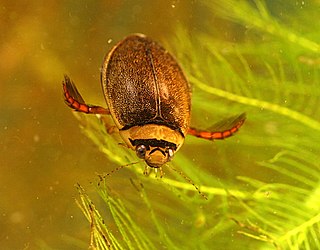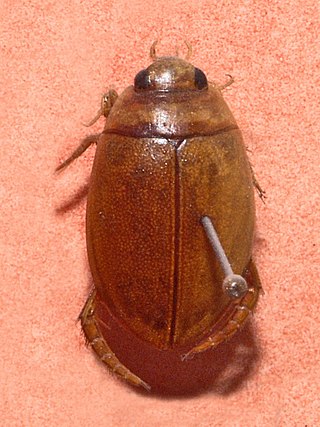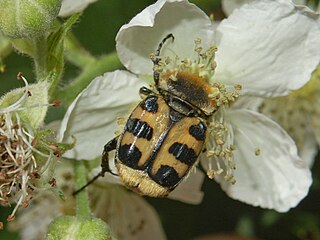
The Dytiscidae – based on the Greek dytikos (δυτικός), "able to dive" – are the predaceous diving beetles, a family of water beetles. They occur in virtually any freshwater habitat around the world, but a few species live among leaf litter. The adults of most are between 1 and 2.5 cm (0.4–1.0 in) long, though much variation is seen between species. The European Dytiscus latissimus and Brazilian Megadytes ducalis are the largest, reaching up to 4.5 cm (1.8 in) and 4.75 cm (1.9 in) respectively. In contrast, the smallest is likely the Australian Limbodessus atypicali of subterranean waters, which only is about 0.9 mm (0.035 in) long. Most are dark brown, blackish, or dark olive in color with golden highlights in some subfamilies. The larvae are commonly known as water tigers due to their voracious appetite. They have short, but sharp mandibles and immediately upon biting, they deliver digestive enzymes into prey to suck their liquefied remains. The family includes more than 4,000 described species in numerous genera.

Dytiscus latissimus is a large species of aquatic beetle in family Dytiscidae. It is native to Europe and considered threatened.

Graphoderus bilineatus is a species of beetle in family Dytiscidae. The IUCN Red List reports it from Austria, Belgium, Bosnia and Herzegovina, Croatia, the Czech Republic, Denmark, Finland, France, Germany, Hungary, Italy, Latvia, Lithuania, Luxembourg, the Netherlands, Norway, Poland, Russia, Serbia and Montenegro, Slovakia, Switzerland, Turkmenistan, Ukraine, and the United Kingdom.

Graphoderus is a genus of beetle in family Dytiscidae native to the Holarctic.

The bee beetles are scarab beetles of the subfamily Cetoniinae.

Ilybius chalconatus is a species of beetle native to the Palearctic, including Europe, the Near East and North Africa. In Europe, it is found in Austria, Belgium, Bosnia and Herzegovina, Britain, Bulgaria, Corsica, Crete, Croatia, the Czech Republic, mainland Denmark, Estonia, Finland, mainland France, Germany, mainland Greece, Hungary, Ireland, mainland Italy, Kaliningrad, Latvia, Lithuania, Luxembourg, Moldova, North Macedonia, Poland, mainland Portugal, Russia, Sardinia, Sicily, Slovakia, Slovenia, mainland Spain, Sweden, Switzerland, the Netherlands, Ukraine, and Yugoslavia.

Graphoderus austriacus is a species of beetle in family Dytiscidae.

Anthrenus museorum, commonly known as the museum beetle, is a species of beetle found in the Palearctic, the Near East and the Nearctic. In its larval form it damages all forms of dry skin and hair. The larva will also eat dry cheese, flour or cocoa occasionally. It is considered a pest, as it damages, among others, the skin of taxidermied animals, such as polar bears and big cats in museums.

Trichius gallicus is a beetle species belonging to the family Scarabaeidae, subfamily Cetoniinae. It frequently appears in the literature under the name "Trichius rosaceus", but this name is permanently unavailable under ICZN Article 11.4, as are all of Voet's names.

Chalcolepidius zonatus is a species of beetles in the family Elateridae.

Aristobia reticulator is a species of beetle in the family Cerambycidae. It is known from Bhutan, Myanmar, India, China, Laos, Bangladesh, Thailand, and Vietnam. It feeds on Prunus persica, Liquidambar formosana, Quercus acutissima, Prunus salicina, and Nephelium mutabile. Many references list the name as Aristobia testudo, but this name, though published earlier, is unavailable under the ICZN, primarily in that Johann Eusebius Voet's 1778 work giving the name testudo fails to fulfill the requirement in ICZN Article 11.4 that a work must be consistently binomial; none of Voet's 1778 names, including testudo, are available.
Nemophas zonatus is a species of beetle in the family Cerambycidae. It was described by Lansberge in 1880. It is known from Indonesia.
Lochmaeocles zonatus is a species of beetle in the family Cerambycidae. It was described by Dillon and Dillon in 1946. It is known from Guyana, Trinidad and Tobago, and French Guiana.

Eutrichites zonatus is a species of ant-loving beetle in the family Staphylinidae. It is found in North America.

Eutrichites is a genus of ant-loving beetles in the family Staphylinidae. There are at least two described species in Eutrichites.

Graphoderus occidentalis is a species of predaceous diving beetle in the family Dytiscidae. It is found in North America.
Graphoderus perplexus, the predacious diving beetle, is a species of predaceous diving beetle in the family Dytiscidae. It is found in North America and the Palearctic.
Graphoderus fascicollis is a species of predaceous diving beetle in the family Dytiscidae. It is found in North America.
Kaučers Protected Landscape is located in Rušona Parish, Preiļi Municipality in the Latgale region of Latvia. The area is named after Lake Kaučers, which is located in the center of the protected area. There are six other lakes in the protected area: Lake Baiba, Esereits, Limins, Meirauka, Salmejs and Lake Stupon. The state highway V742 passes through the northern part of the territory. Next to it is Gaiļmuiža. This is an Natura 2000 site.













